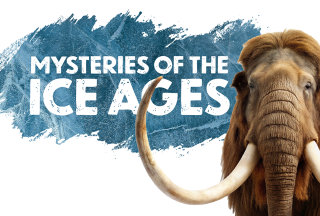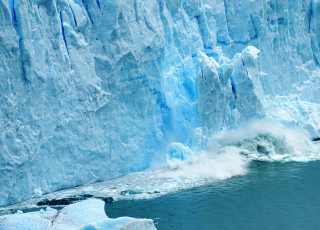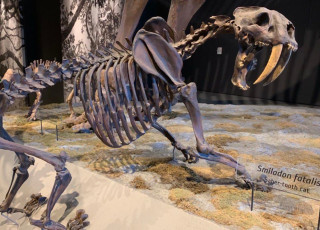Tusks Up, Utah: Remarkable Mammoths, Mascots, and Ice Age Icons
By Olivia Barney

Utah Mammoth / Smith Entertainment Group
The Utah Hockey Club’s recent rebranding to Utah Mammoth is an Ice-Age inspiration that has NHL fans around Utah and the nation buzzing! Here at the Natural History Museum of Utah, our mammoth-loving team could be seen cheering, chattering, and celebrating the big news. It was like our version of the Stanley Cup — a scientific victory that paid homage to Utah’s rich paleontologic legacy.
The mammoths that roamed Utah 10,000 years ago were towering animals whose footsteps, diets, and day-to-day lives helped shape the land we now call home. The Columbian mammoths that roamed Utah (and their more famous Woolly cousins) are the quintessential Ice Age animals — powerful, imposing creatures that make perfect mascots for Utah's hockey players on and off the ice.
But what if the Utah Hockey Club had chosen a different Ice Age icon to represent the team? In honor of our newest special exhibition, Mysteries of the Ice Ages, which is open until January 4, 2026, we’re looking at other extinct animals that once roamed North America and could have made fitting NHL mascots!
Dire Wolf (Team Name: Deseret Dires)

Lyndsie Leavitt / NHMU
An Ice Age animal that’s received recent public attention is the ever impressive dire wolf. Despite abundant claims of “cloned” dire wolves reestablishing the animals within our current ecosystems, the species has not been resurrected. (Ask us why here.)
When we think of dire wolves, images of ferocious canines flicker through our minds, influenced by the TV shows and movies that made them infamous. For years, scientists believed that the gray wolf (Canis lupus) was the dire wolf’s closest living relative, but in recent years, that’s changed. Current research indicates that dire wolves are more closely related to African jackals (Canis aureus) than gray wolves — despite the similar morphological traits that both gray and dire wolves developed during their evolution. In fact, there’s such a large genetic gap between dire wolves and modern Canis species that their scientific name was changed from Canis dirus to Aenocyon dirus, reclassifying dire wolves into a new genus of which they are the only species.
Though these carnivores would have made for an imposing mascot, their fossil record within Utah specifically is far less prominent than the dozens of mammoths which have been found across the state — a disconnect that disrupts the sense of belonging found in the new Utah Mammoth identity.
Saber-Toothed Cat (Team Name: Salt Flat Sabers)

Lyndsie Leavitt / NHMU
In terms of picking an Ice Age animal that embodies power and grace, the saber-toothed cat (Smilodon fatalis) is another great mascot option. This sly animal showcased prominent, elongated canine teeth — perfect for a fearsome hunter. These large cats, which were approximately the size of lions, prowled across North America during the Late Pleistocene. They featured short bobtails and 11 razor-sharp teeth, making these saber-toothed animals a fearsome predator.
Though they’re often nicknamed “saber-toothed tigers,” these cats belonged to an extinct branch of the cat family: Machairodontinae. And unlike many of the big cats that roam Earth today, saber-tooths rarely chased down their meals. Instead, they waited for prey to come closer, using their muscular forms to pounce on and restrain their prey.
Giant Short-Faced Bear (Team Name: Canyonland Crushers)

Lyndsie Leavitt / NHMU
For a hockey team seeking a mascot that exemplifies speed, the giant short-faced bear (Arctodus simus) is an excellent option. This extinct species, which stood about 5 feet tall at its shoulders and 12 feet tall when standing on its hind legs, was the fastest species of bear that’s ever lived. Also called the bulldog bear, this animal walked with a steady, purposeful gait and could likely run over 40 miles per hour — despite its massive, 1,500-pound frame.
With a strong jaw that could crush bones to extract bone marrow, these carnivorous animals roamed the northwest, preying on everything from bison to ground sloths. The only living relative of the giant short-faced bear lives in South America. This ancestor, the spectacled bear (Tremarctos ornatus), is a smaller omnivore approximately the size of a black bear.
Giant Ground Sloth (Team Name: Green River Giants)

Lyndsie Leavitt / NHMU
If the Utah Hockey Club’s aim was to choose a mascot with closer ties to Utah, the giant ground sloth would make an excellent contender. Utah’s geological history has uncovered two kinds of ground sloths that once roamed the area. The first, Jefferson’s ground sloth (Megalonyx jeffersoni), was discovered in a Lake Bonneville Shoreline deposit near Provo, and the species was named in honor of Thomas Jefferson, the third President of the United States. It was massive — the size of a bison — and measured 12 feet tall at the shoulders! Harlan’s ground sloth (Paramylodon harlani), the second ground sloth known to inhabit the Utah region, was larger than the Jefferson — this one named in honor of Richard Harlan, a famous 19th century American paleontologist.
Their imposing size and presence within the Utah fossil record make the giant ground sloth an interesting candidate for a team mascot, but like their slow-moving relatives in South America, they hardly invoke the vision of speed that fans expect from a hockey team — also lacking the ferocity of the dire wolf and the grandeur of the Columbian mammoth.
Giant Beaver (Team Name: Bonneville Beavers)

Lyndsie Leavitt / NHMU
Approximately 10,000 years ago, giant beavers roamed across North America from Florida to Alaska. These hulking rodents reached about 220 pounds and stood five feet tall, resembling modern beavers in many ways. But there were a handful of difference between the extinct giants and their contemporary relatives. Physically speaking, the giant beaver (Castoroides ohioensis) featured two large distinctions. First, its teeth were bulky and curved, making them far blunter than the sharp incisors we see today. Second, giant beavers lacked the iconic paddle-like tails of their modern relatives. Instead, their tails were long and skinny, much like a rat.
Their behavior was also different. The giant beaver fed exclusively on aquatic plants. It didn’t cut down trees or manufacture dams but found shelter among the wetlands. An Ice Age icon? Absolutely. But an awe-inspiring mascot? Not so much.
Tusks Up for Mysteries of the Ice Ages
Although the Ice Age Epoch featured a wide variety of impressive animals, we’re glad the Utah Hockey Club chose a mascot that resonated more strongly with Utah’s geological past — besides, Utah Mammoth does have a nice ring to it.
Get in the mammoth spirit ahead of the 2025-2026 NHL season by uncovering more Mysteries of the Ice Ages. This summer at NHMU, you can take a closer look at the not-so-distant past that was home to thundering mammoths and mastodons, giant bears and beavers, fearsome wolves, and saber-toothed cats. Mysteries of the Ice Ages is a special exhibition open now — prebook your tickets here to experience the coolest special exhibition Utah’s ever seen.
Tusks up, Utah!

Uncover Ice Age Mysteries
More mammoths are visiting Salt Lake City! A new special exhibition exploring the last 80,000 years of Earth's Ice Age is open now for a limited time.




